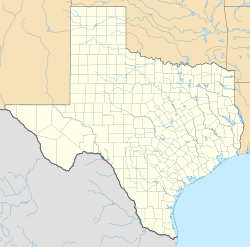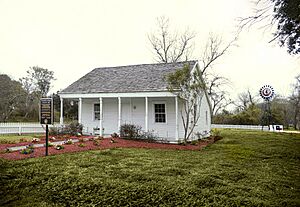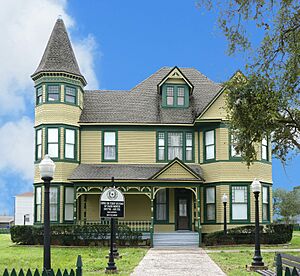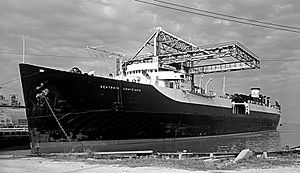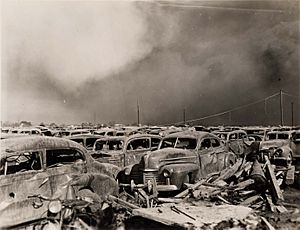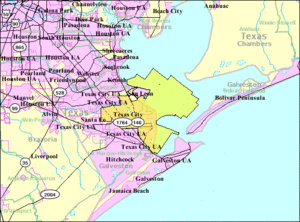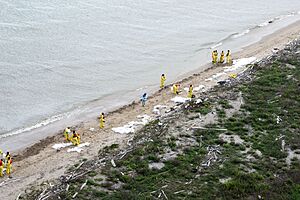Texas City, Texas facts for kids
Quick facts for kids
Texas City, Texas
|
|
|---|---|
| Motto(s):
"The city that would not die"
|
|
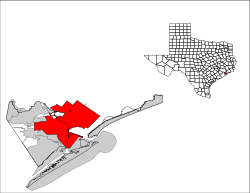
Location in Galveston County in the state of Texas
|
|
| Country | United States |
| State | Texas |
| County | Galveston |
| Founded | 1830s |
| Incorporated | 1911 |
| Government | |
| • Type | Council-Mayor |
| Area | |
| • City | 186.58 sq mi (483.24 km2) |
| • Land | 66.27 sq mi (171.62 km2) |
| • Water | 120.31 sq mi (311.61 km2) |
| Elevation | 10 ft (3 m) |
| Population
(2020)
|
|
| • City | 51,898 |
| • Estimate
(2022)
|
55,667 |
| • Rank | US: 719th TX: 69th |
| • Density | 840/sq mi (324.4/km2) |
| • Urban | 191,863 (US: 200th) |
| • Urban density | 1,760.5/sq mi (679.7/km2) |
| Time zone | UTC–6 (Central (CST)) |
| • Summer (DST) | UTC–5 (CDT) |
| ZIP Codes |
77510, 77539, 77568, 77590, 77591, 77592
|
| Area code(s) | 409 |
| FIPS code | 48-72392 |
| GNIS feature ID | 1376420 |
Texas City is a city in Galveston County, Texas, United States. It sits on the southwest shore of Galveston Bay. Texas City is known for its deepwater port on Texas's Gulf Coast. It is also a major center for making petroleum and petrochemical products. In 2020, about 51,898 people lived there. This makes it the third-largest city in Galveston County. Texas City is part of the larger Houston metropolitan area. The city is famous for a huge explosion in 1947 that destroyed much of its port and parts of the city.
Contents
History of Texas City
In 1891, three duck hunters from Minnesota thought a spot called Shoal Point could become a big port. This area had been around since the 1830s. Veterans of the Texas Revolution (1835–1836) were given land here. The duck hunters, Benjamin, Henry, and Jacob Myers, bought a large area of land. They renamed it Texas City.
How Texas City Was Founded
By 1893, the investors formed the Texas City Improvement Company (TCIC). They planned the town and opened a post office. About 250 people from Minnesota and Michigan moved there. The TCIC also got permission to dig a channel in the bay. This channel helped ships reach Texas City. In 1894, the channel was first used by businesses. The TCIC also built a railroad to connect to other train lines.
However, the TCIC went out of business in 1897. Its parts were split into two new companies: Texas City Company (TCC) and Texas City Railway Terminal Company (TCRTC). TCC managed city lots and provided services like water and electricity. TCRTC ran the railroad.
Streets were planned in the 1890s, and homes began to appear. The Davison Home, where the first baby was born in town, was built around 1895-1897.
In 1900, permission was given to make the Texas City channel even deeper. A big hurricane in 1900, the Galveston Hurricane, slowed the project. But the Texas City port stayed open. The first large ship arrived in 1904. By 1905, the US government opened a customs house. The port grew quickly, from 12 ships in 1904 to 239 in 1910.
Texas City Refining Company started in 1908. It built a refinery next to the port. This refinery was special because it could make wax and lubricating oil. More refineries followed, making Texas City a key port for shipping oil products.
Texas City officially became a city in 1911. William P. Tarpey was chosen as the first mayor.
In 1913, the United States Army sent soldiers to Texas City. They were there to protect the Gulf Coast during the Mexican Revolution. This made Texas City a very important military spot. The 1st Aero Division was also there. The Wright brothers trained soldiers to be military pilots. This means Texas City is considered the birthplace of the United States Air Force.
A hurricane in August 1915 destroyed the army camp. Nine soldiers died. The army then moved the camp to San Antonio.
In 1921, the Texas City Railway Terminal Company took over the port. They expanded it a lot. They brought in a sugar refinery, a fig processing plant, and more. By 1925, Texas City had about 3,500 people. It was a busy town with refineries and other businesses.
The Great Depression caused the sugar refinery to close in 1930. But the oil business helped the city recover. More refineries opened in the 1930s. By the end of the 1930s, Texas City's population grew to 5,200.
Seatrain Lines built a terminal at the port in 1939-1940. This company used special ships to carry railroad cars from Texas City to New York City. By 1940, Texas City was the fourth-busiest port in Texas.
Texas City Dike
Texas City is home to the Texas City Dike. This is a long, man-made wall built in the 1930s. It was made to protect the Houston Ship Channel from getting filled with dirt. Locals call it "the world's longest man-made fishing pier". It stretches about 5.2 miles (8.4 km) into Galveston Bay.
World War II and Texas City
During World War II, Texas City grew even more. Refineries and chemical plants worked nonstop. They supplied oil and other materials for the war. The government also built a tin smelter and a plant to make styrene monomer. This material was needed for synthetic rubber. Monsanto Chemical Company ran this plant. By 1950, the city's population reached 16,620.
The 1947 Texas City Disaster
On April 16, 1947, a French ship called the Grandcamp exploded. It was carrying ammonium nitrate fertilizer. This event is known as the Texas City disaster. It is one of the worst industrial accidents in U.S. history. The explosion destroyed the Monsanto plant nearby. It also blew up warehouses and sent ship parts flying. A second ship, the S.S.High Flyer, caught fire and exploded too. Both ships were carrying the same fertilizer.
In total, 581 people died, and over 5,000 were hurt. Many emergency workers who responded to the first explosion were never found. The entire Texas City Fire Department was lost. The explosions were so strong that people 14 miles (23 km) away in Galveston were knocked down. Homes near the port were destroyed.
The city recovered well from the accident. Many petrochemical refineries are still in the same port area. Texas City is often called "the town that would not die."
Later Industrial Incidents
On October 30, 1987, there was a chemical release at the Marathon Oil refinery. A crane dropped its load on a tank of liquid hydrogen fluoride. This caused a gas release, and 3,000 residents had to leave their homes.
On March 23, 2005, another explosion happened at a local BP oil refinery. This accident killed 15 people and injured 180. The U.S. Chemical Safety and Hazard Investigation Board called it "one of the worst industrial disasters in recent U.S. history." The BP facility in Texas City is one of the largest oil refineries in the United States.
Hurricane Ike in 2008
When Hurricane Ike hit in 2008, Texas City was mostly protected. The city has a 17-mile (27 km) long levee system built in the 1960s. This levee, along with pump stations, helped save the city from the storm's powerful storm surge. Damage was mainly from strong winds and heavy rains.
After the hurricane, Texas City's high school football stadium was used to help people evacuated from nearby areas. The American Red Cross also opened a relief center in the city.
The Texas City Dike was covered by a storm surge of over 12 feet (3.7 m). All buildings and piers on the dike were destroyed. However, the dike itself survived. It was closed for three years for repairs and reopened in September 2011.
Geography of Texas City
Texas City is about 10 miles (16 km) northwest of Galveston. It is about 37 miles (60 km) southeast of Houston.
The city covers a total area of about 186.58 square miles (483.24 km²). Most of this area, about 120.31 square miles (311.61 km²), is covered by water. The land area is about 66.27 square miles (171.62 km²).
Texas City's official elevation is 10 feet (3 m) above sea level. Some areas are even lower. This makes the city naturally prone to flooding from hurricanes and heavy rains.
The land to the south and west of the city is a flat coastal plain. A large part of this area is marshland. Moses Lake borders Texas City to the north. This lake flows into Galveston Bay, which is to the east of the city.
Population and People
| Historical population | |||
|---|---|---|---|
| Census | Pop. | %± | |
| 1920 | 2,509 | — | |
| 1930 | 3,534 | 40.9% | |
| 1940 | 5,748 | 62.6% | |
| 1950 | 16,620 | 189.1% | |
| 1960 | 32,065 | 92.9% | |
| 1970 | 38,908 | 21.3% | |
| 1980 | 41,201 | 5.9% | |
| 1990 | 40,822 | −0.9% | |
| 2000 | 41,521 | 1.7% | |
| 2010 | 45,099 | 8.6% | |
| 2020 | 51,898 | 15.1% | |
| 2022 (est.) | 55,667 | 23.4% | |
| U.S. Decennial Census 2020 Census |
|||
2020 Census Information
| Race | Number | Percentage |
|---|---|---|
| White (NH) | 18,822 | 36.27% |
| Black or African American (NH) | 14,189 | 27.34% |
| Native American or Alaska Native (NH) | 158 | 0.3% |
| Asian (NH) | 680 | 1.31% |
| Pacific Islander (NH) | 34 | 0.07% |
| Some Other Race (NH) | 224 | 0.43% |
| Mixed/Multi-Racial (NH) | 1,675 | 3.23% |
| Hispanic or Latino | 16,116 | 31.05% |
| Total | 51,898 | 100.00% |
In 2020, Texas City had 51,898 people living there. There were 19,526 households and 13,005 families.
The percentage of Hispanic and Latino people in Texas City has grown over time. In 2017, it was 29.9%, up from 27% in 2010. The city now has businesses that serve the Hispanic community.
Economy and Industry
Texas City's economy has always relied on heavy industry. This includes shipping at the Port of Texas City. It also includes making petroleum and petrochemical products. The Texas City Industrial Complex is a major center for the petrochemical industry. The Galveston Bay Refinery is one of the largest oil refineries in Texas and the U.S.
The Port of Texas City is a very busy port. It is the eighth-largest port in the United States. It handles over 78 million tons of goods each year. The Texas City Terminal Railway Company helps connect the port to land. It moves over 25,000 train carloads every year.
In recent years, city leaders have tried to add other types of businesses. They want to grow tourism, health care, and other areas.
The Galveston County Juvenile Justice Department has a center in Texas City. Also, the Texas Department of Criminal Justice has a medical facility for females in the city.
Arts and Culture
In 1928, Texas City opened a public library in its city hall. After the 1947 explosion damaged city hall, the library moved. In 1964, it moved into its current building. The Moore Memorial Public Library was expanded in 1984.
The Texas City Museum has a cool exhibit. It includes the Galveston County Model Railroad Club exhibit.
Parks and Outdoor Fun
Texas City has 42 parks. Some of these parks are part of the Great Texas Coastal Birding Trail. This trail is great for watching birds.
The Texas City Prairie Preserve is a large nature area. It covers 2,300 acres (930 ha) on the shores of Moses Lake. The preserve has prairie and wetland areas. Part of it is open to the public for camping. You can also take tours and walk on boardwalks through the marshes.
Bay Street Park is a 45-acre (18 ha) park near the bay. Part of this park honors the Aero Squadron. This was one of the first U.S. Army air squadrons. It was a very early part of what is now the modern Air Force. The park also has nature trails and family fun areas.
Nessler Park is a 55-acre (22 ha) park. It is used for community events, like the "Music Fest by the Bay." Other big city parks include Carver Park, Godard Park, and Holland Park.
The Davison Home is a historic house in Texas City. It was built in 1897 and is a centerpiece of the Heritage Square historical district.
Education in Texas City
Schools for Kids and Teens
Public Schools
Most students in Texas City go to schools in the Texas City Independent School District. This district has four elementary schools for grades K-4. They are Kohfeldt, Roosevelt-Wilson, Heights, and Guajardo Elementary. Levi Fry Intermediate School is for fifth and sixth graders. Blocker Middle School is for seventh and eighth graders. Texas City High School serves the older students.
Some parts of Texas City are in the Dickinson Independent School District.
In 2016, the Texas City Independent School District also took over the La Marque Independent School District.
Private Schools
Our Lady of Fatima School is a Roman Catholic elementary school in Texas City. It is run by the Roman Catholic Archdiocese of Galveston-Houston.
Colleges and Universities
Texas City is home to College of the Mainland. This college is located right in the city.
City Services
Transportation
The main highway in the area is the Gulf Freeway, which is part of Interstate 45. This freeway connects Texas City to Galveston and Houston. Texas State Highway 146 connects Texas City to other towns along Galveston Bay. Texas Loop 197 and Highway 146 form a loop around the city. This helps people get to different parts of Texas City.
Police Department
In 2008, Texas City changed how it handled some city rules. They replaced civilian officers with police officers. This was done because people were not always following the rules set by civilian officials.
Famous People from Texas City
- Chris Ballard, NFL Colts General Manager
- Charles Brown, blues singer and pianist
- John Carona, politician
- Frank B. Davison, city pioneer who built Davison home, now a museum
- George Ducas, country music singer
- Charlie Dupre, former NFL player
- L.G. Dupre, former NFL player
- Ben Emanuel, American football player
- D'Onta Foreman, professional football player
- Andy Hassler, professional baseball player
- Johnny Lee, country music singer
- Edi Patterson, actress on The Righteous Gemstones
- Stone Phillips, television reporter and correspondent
- Ron Raines, actor
- Mary Simpson, one of the first women to be ordained a priest by the American Episcopal Church
- Donna Wick, author and broadcaster
See also
 In Spanish: Texas City (Texas) para niños
In Spanish: Texas City (Texas) para niños


